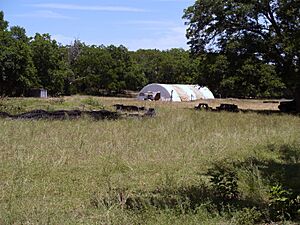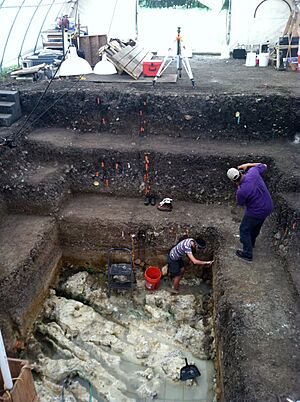Gault (archaeological site) facts for kids
The Gault archaeological site is a very important place in central Texas, United States. It's about 40 miles (64 km) north of Austin. This site shows that people have lived here almost continuously for at least 16,000 years. This makes it one of the few places in the Americas with strong proof of humans living there even before the well-known Clovis culture appeared.
Contents
Why is the Gault Site So Important?
For many years, archaeologists wondered when the first people arrived in North and South America. For a long time, most thought that the first people were those who made and used special tools called Clovis "points". They believed these people arrived about 13,500 years ago and quickly spread everywhere.
However, some archaeologists believed people were here much earlier. In recent decades, more and more sites have been found and studied. These sites have reliable dates showing that people were in the Americas thousands of years before the Clovis culture.
Most of these older sites are far apart. They often don't have many tools to show a clear pattern of how tools were made and used. To understand these older technologies better, archaeologists need sites that are:
- Well-stratified: This means the layers of soil are clear, showing different time periods.
- Contain both older and Clovis materials: This helps compare tools from different times in the same place.
- Show long periods of occupation: This means people lived there for a long time, doing many different activities and using many kinds of stone tools.
The Gault site is special because it has all these things.
Layers of History at Gault
The Gault site has layers of soil that show different time periods:
- Pre-Clovis: More than 13,500 years ago.
- Clovis: 13,500 to 13,000 years ago.
- Late Paleoindian: 13,000 to 9,000 years ago.
- Archaic: 9,000 to 1,200 years ago.
- Late Prehistoric: 1,200 to 500 years ago.
People lived here for so long because of the site's great location. It's next to two different areas rich in resources: the Edwards Plateau uplands and the lower Blackland Prairie. Water from Buttermilk Creek was always available, even during dry times. A wide variety of food resources were also found here.
Gault was also a place where people could find good quality stone for tools. This stone, called Edwards chert, was easy to find in the banks of the creek. Chert from the Edwards Plateau was used for tools found as far away as the Lindenmeier site in Colorado.
Amazing Clovis Discoveries
The Gault site has an incredible amount of Clovis artifacts. Archaeologists have found about 650,000 Clovis items. These include flakes (small pieces broken off when making tools), cores (the main stone from which flakes are removed), and finished tools. This huge number suggests that many people gathered here, or that people lived here for a very long time.
This discovery challenges the old idea that Clovis groups were always moving around, only hunting large animals. At Gault, archaeologists found bones from many different animals. These include large animals like mammoths and bison, but also medium-sized and small animals like horses, deer, rabbits, birds, and turtles. This shows that the people at Gault ate a wide variety of foods.
One of the most important finds at Gault is that it's one of only twenty mammoth kill sites in the United States. This means people hunted and killed mammoths here.
Because of its importance, the Gault site was officially added to the National Register of Historic Places on May 29, 2018. It is also a Texas State Antiquities Landmark.
History of the Gault Site
The Gault site is named after Henry Gault. He started a 250-acre farm in the Buttermilk Creek Valley in 1904. In the early 1900s, he helped early archaeologists in Central Texas. He worked with J.E. Pearce, the first professional archaeologist in Texas, and other amateur archaeologists.
The first official digs at the Gault site happened in 1929. Professor J. E. Pearce from the University of Texas was interested in the large Archaic midden (a pile of ancient trash) at Gault, which contained many artifacts.
Unfortunately, letters from Pearce's time show that a lot of looting happened at the Gault site in 1929. This continued for many years, as it was even a "pay-to-dig" site. This practice finally stopped in 1998 when new owners took over. Luckily, the looters usually didn't dig into the older, deeper layers because there weren't as many valuable artifacts there.
Small test digs were done in 1991. Then, serious geoarchaeological studies began in 1998 and continued until 2002. They started again from 2007 to 2015. These studies were led by the Texas Archaeological Research Laboratory at the University of Texas at Austin, the Gault School of Archaeological Research (GSAR) [1], and the Prehistory Research Project at Texas State University [2].
In 2007, The Archaeological Conservancy [3] bought the site and was given it as a gift. Today, the GSAR manages most of the site for the Conservancy. They offer tours and educational programs for people to learn about this amazing place.
Archaeological Excavations at Gault
Archaeologists have dug in 15 different areas at the Gault site. They also used machines to dig trenches and boreholes. They even used special non-invasive tools to scan the ground without digging.
The work from 1998 to 2002 focused on the early layers that had not been disturbed by looters. They found a sequence of cultural materials from early Paleoindian to early Archaic times. This included different tool styles like Clovis, Folsom, Wilson, St. Mary's Hall, Cody, Golondrina, Barber, Angostura, Hoxie, and Gower. Of all these, Clovis tools were found in the largest numbers. The Gault site is unique because it has examples of all 11 cultures that might be found at archaeological sites in central Texas.
Discovering Pre-Clovis Life
From 2007 to 2014, archaeologists focused on Area 15 of the Gault Site. They were looking for evidence of people living there even before the Clovis period. They had seen hints of this in earlier test digs. They dug a large area, about 48 square meters (517 sq ft), going down 3.5 meters (11.5 ft) from the surface to the solid rock below. This digging uncovered 12 square meters (129 sq ft) of the bedrock.
Surprisingly, part of this area had escaped looting. It had untouched archaeological layers just below the surface. Evidence from the soil layers (called stratigraphy) and luminescence dating (a way to tell how long ago soil was last exposed to light) all showed a clear sequence. This sequence included:
- An older occupation (pre-Clovis).
- Clovis.
- Late PaleoIndian.
- Early Archaic.
- Middle/Late Archaic.
This shows that people lived at the Gault site for more than 16,000 years!
Thousands of tools were taken from the site by collectors before professional digs began. However, a huge number of tools and debitage (waste flakes from tool making) still remained. So far, about 2.6 million artifacts have been found from only 3% of the site. This includes artifacts from all the main cultural periods in Central Texas. The largest number (over 600,000) are from the Clovis age. A significant number (150,000) of artifacts, called "The Gault Assemblage," come from the untouched older layers.
These findings are described in more detail in a paper called "Evidence of an early projectile point technology in North America at the Gault Site, Texas, USA."
Archaeologists also found a stone pavement, about 2 by 3 meters (6.6 by 9.8 ft), that dates back to at least the Clovis age. This pavement, with debris around it, might be the earliest sign of a structure or dwelling in North America. More than 100 stones with carvings and one engraved bone have also been found. The oldest of these, from the Clovis period, might be the earliest portable art found in a secure context in North America.



